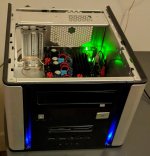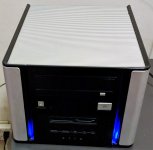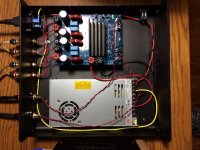I measured the EVM3255 and can reassure you that it produces hi-quality output. Removing SE-caps is an option that will do no harm, replacing any caps is not worth the effort or money.
Output filter affects the upper end of audio band only, i.e. the region close to 20khz. Optimizing for your speaker according to TIs table is a bit of a theoretical attempt: All these frequency plots are carried out under lab conditions with low inductive dummy loads. But real speaker loads are far from being low inductive resistors, thus frequency response of the amp will be different in reality. Following this I would expect some more boost at 20khz compared to the data sheet.
This is one of my personal points of critic with TIs post-filter feedback concept.
I would not go for 15uH inductors. Even with 8.2uH I achieve fine results measuring my homebrewed "EVM"
All in all - you should take these filter calculators with a grain of salt.😉
Output filter affects the upper end of audio band only, i.e. the region close to 20khz. Optimizing for your speaker according to TIs table is a bit of a theoretical attempt: All these frequency plots are carried out under lab conditions with low inductive dummy loads. But real speaker loads are far from being low inductive resistors, thus frequency response of the amp will be different in reality. Following this I would expect some more boost at 20khz compared to the data sheet.
This is one of my personal points of critic with TIs post-filter feedback concept.
I would not go for 15uH inductors. Even with 8.2uH I achieve fine results measuring my homebrewed "EVM"
All in all - you should take these filter calculators with a grain of salt.😉
Last edited:
But if your dad hade given you the rifle, you would write in different forums now😀Finally I get something I want for Xmas. Still mad at my dad that I got a "plastics engineering kit" instead of a .22 target rifle. And that was probably 55 years ago. Thanks - Pat
Well...turns out that I'm having trouble melting the solder for the electrolytics. Don't want to turn the heat too high and cause any damage.
I'll leave the amp as is. Thanks for the advice.
Mike
I'll leave the amp as is. Thanks for the advice.
Mike
Question - would it not make more sense to replace the input caps C20,71,62,66 - preferably with an input transformer? And R7 and R20? Using the board only in two channel stereo.
If you're going to bypass all those things and place a transformer, why not do it from the "audio interface board" and open up R4, R12, R44, R46? You shouldn't need the NE5532's as a buffer. (I'd need to look on the board themselves to see if it's a bridged solder blob or wire jumper)
Question - would it not make more sense to replace the input caps C20,71,62,66 - preferably with an input transformer? And R7 and R20? Using the board only in two channel stereo.
You will spoil the low THD of TPA3255, specially at low frequencies, with any input transformer.
Last edited:
Thanks for that info - I admit my ears tell me so far that no modes are necessary - I am still pretty impressed by the board's performance.
Well...turns out that I'm having trouble melting the solder for the electrolytics. Don't want to turn the heat too high and cause any damage.
I'll leave the amp as is. Thanks for the advice.
Mike
Lead free. Will be a real PITA. Not worth it, man. Just let it go and enjoy.
Thanks to everyone for the suggestions on DACs with balanced outputs. I've got a lot of research to do. The TOPPING DX7 also looks interesting, but is a bit more than I care to spend. The remote is a nice touch, though.
Amazon.com: Full Balanced DAC Headphone Amplifier Topping DX7 32BIT/384KHz DSD USB Full Balanced DAC Headphone Amplifier (Black): Cell Phones & Accessories
Amazon.com: Full Balanced DAC Headphone Amplifier Topping DX7 32BIT/384KHz DSD USB Full Balanced DAC Headphone Amplifier (Black): Cell Phones & Accessories
...
But real speaker loads are far from being low inductive resistors, thus frequency response of the amp will be different in reality. Following this I would expect some more boost at 20khz compared to the data sheet.
This is one of my personal points of critic with TIs post-filter feedback concept.
...
Can you expand on that?
As far as I can tell PFFB is meant to lessen the impact of the output filter, and to some extent compensate for the speaker impedance curve.
Anyone suggest the simplest way to run external clip and fault leds from this board? I assume the connection points on the board go high when active? 3.3v or 15v?
Any issues with paralleling the clip/fault outputs of two boards to one pair of led's?
Any issues with paralleling the clip/fault outputs of two boards to one pair of led's?
Anyone suggest the simplest way to run external clip and fault leds from this board? I assume the connection points on the board go high when active? 3.3v or 15v?
Any issues with paralleling the clip/fault outputs of two boards to one pair of led's?
ok should really check the schematic before posting.. so its active LOW for the clip and error outputs. however i note that the mosfet used to drive the little onboard LED is rated for 100-170ma. so i guess i could just remove the existing onboard led and run a 5mm standard jobby no sweat. similar current rating anyway.
EVM3255 and 48 volt Mean Well PS in old Antec Aria computer case. The case's plastics are brittle, with some tabs broken off, so I gave up on the idea of trying to do anything with the power button on the front of the case. I put a toggle switch and fuse holder in the rear metal panel, next to the existing IEC module.
Attachments
I finally rigged up my board two days ago and have been listened to it for a few hours. Really like the sound. Waiting for my MW power supply and the case that I bought. Once everything arrived, both the board and the PSU will be housed inside the case.
I like everything about the amp board, except one thing. I think someone might have mentioned it before (not 100% sure). When the PSU supplying the board is switched off (the PSU connect to the amp directly). there is a pop after a 2-3 second of delay (the caps are discharging?). Are there any good ways to get rid of it? Thanks!
Regards,
I like everything about the amp board, except one thing. I think someone might have mentioned it before (not 100% sure). When the PSU supplying the board is switched off (the PSU connect to the amp directly). there is a pop after a 2-3 second of delay (the caps are discharging?). Are there any good ways to get rid of it? Thanks!
Regards,
<< interested in the answer as I'm also getting this board soon >>
In my TPA3251 board, from 3eAudio, there is a faint click at startup, but nothing at shutdown. It was not there initially, but it has developed after 3 months of usage. I wonder if its because of the RPi or the board.
In my TPA3251 board, from 3eAudio, there is a faint click at startup, but nothing at shutdown. It was not there initially, but it has developed after 3 months of usage. I wonder if its because of the RPi or the board.
Had some initial problems with high pitched noise and some static background noise as well, this occurred while running the TPA3245EVM on a 19V laptop SMPS. Then I switched to my Meanwell SP-150-27 and the problems have been gone ever since. Now the amplifier is as quiet as it gets, there is still some static but you have to press your ear all the way up to the tweeter to be able to hear it.
I had ordered two amps to be used in PBTL mode, one for each speaker. I also ordered 2 SE-600-48V Meanwell power supply. The fan is loudddddddd, will have to do something about it. I have bench tested both amps individually. Was finally able to hook up one of the amp in stereo mode to my Maggies (1.6QR). For comparison, I am running Crown X2000 (aka Crown XLI1500) which is 450W into 4ohms (Maggies are rated at 4ohm). I am using Pioneer VSX 23TXH as preamp. Source is flac over HDMI.
First impression, the bass is definitely there, lot more than crown. The sound is clean even at higher volumes, the distortion is almost non existent. I guess I need to let it run for a few hours tomorrow. Very impressed so far. Will run both amps in PBTL mode in the weekend. Will have to shop for cases also to make it monoblocks.
First impression, the bass is definitely there, lot more than crown. The sound is clean even at higher volumes, the distortion is almost non existent. I guess I need to let it run for a few hours tomorrow. Very impressed so far. Will run both amps in PBTL mode in the weekend. Will have to shop for cases also to make it monoblocks.
Getting close! My OCD forced me to remove one of the three molex wires and move the red/black to match + and - pins on the board.
That's a nice, clean build! I have a touch of OCD, too. Would you mind telling what case you used?
- Home
- Amplifiers
- Class D
- TI TPA3255EVM



